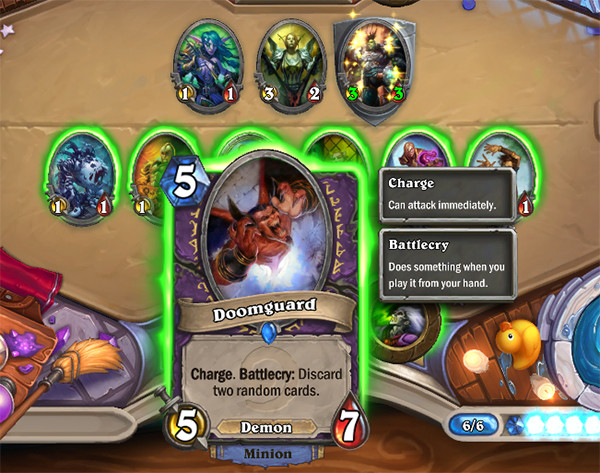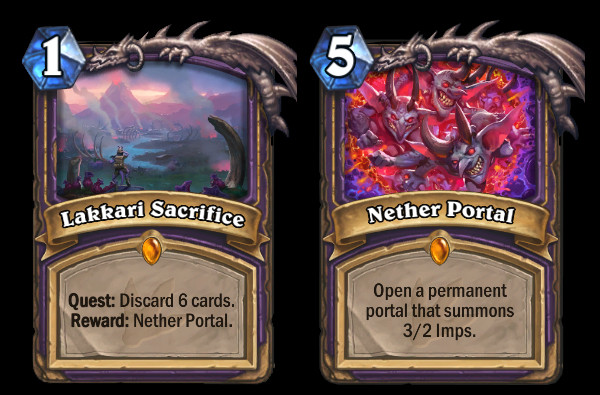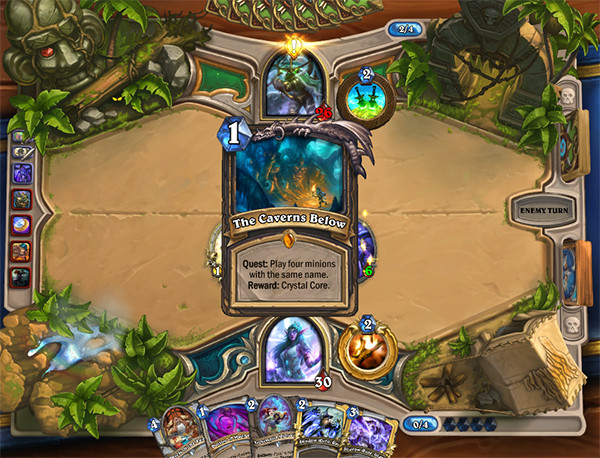About a month has passed since the launch of Journey to Un’Goro, the first expansion heading the Year of the Mammoth. After many Standard cards have rotated out to Wild and Hall of Fame, the meta also has gone through some significant changes. One noticeable shift was the sharp population decline of the Warlock, which used to be one of the favorite classes in Ranked Play. So what happened to Warlock during this period of change?
◈Pre-Un’Goro Warlock: Born with a silver spoon in his mouth
Even before Hearthstone was officially released, the Warlock has historically been among the top classes. If you think about how valuable it is to draw cards in TCG in general, the Warlock’s Hero Power of sacrificing life to draw cards tremendously helped the class in terms of enabling flexible gameplay.
That’s why Zoo decks, which use low-cost minions or Murlocs, synergize well with the Warlock’s Hero Power and became a defining archetype throughout the game’s history. When a Warlock uses up all the cards in hand, which often happens with aggressive decks that quickly eat up cards, he can simply Life Tap every turn to refill his hand. Although Warlock class cards share the common theme of sacrificing minions or discarding cards from a hand, those losses can be mitigated by developing the board with cheap minions and using a powerful card that requires you to discard cards on an empty hand.

Additionally, the supposed penalty of paying life for a card draw could be played to the Warlock’s strategical advantage. Cards like Twilight Drake, Mountain Giant, Molten Giant, and Lord Jaraxxus became the engine that made Handlock control decks work by offering various benefits from having more cards in hand or less Hero health.
The actual composition of cards may have changed over the course of expansions and adventures, but the Warlock’s two-track strategy of Zoo and Handlock provided the class with an appropriate response to the shifting meta. Having two viable archetypes forces the opponent to guess in the mulligan phase whether to hold onto board clear spells for Zoo or removals for big threats like a turn-4 Twilight Drake or Mountain Giant.

◈ Warlock in Gridlock: Dwindling popularity and win rate
Despite the class always occupying the mid to top tiers in any meta, the Warlock suffered major blows in the Un’Goro expansion. According to the meta analysis website, Tempo Storm, the Warlock is ranked in the mid to low tiers and the supposedly-evergreen Handlock was placed near the bottom of the list.
Examining objective data also paints a grim picture for the Warlock. Vicious Syndicate’s weekly vS Data Reaper Report shows Warlock prevalence in Ranked to be less than 2%, compared to popular classes at around 15%. Considering that the distribution of Shaman, the second least popular class, is well over 5%, it’s hard to deny that the Warlock representation has been reduced tremendously.

This trend continues in tournaments as well. In fact, Hearthstone Global Games saw a total of 18 Warlock appearances, as opposed to the most popular Warrior’s 83 and the second least popular Hunter’s 40. Warlock’s win rate hovers around 30%, which is underwhelming compared to most other classes’ win rates, which are about 50%, give or take.
This is the first time that the Warlock has been placed at the bottom of the barrel in the history of Hearthstone, and there are three main factors that undermined the class.

◈ Top 3 reasons for the Warlock’s downfall
1) Too many key cards gone with not enough replacements
The first reason the Warlock met its downfall was that the Year of Mammoth rotated out many key Warlock cards, which made the class what it is.
For instance, Handlocks had to do away with crucial cards like Power Overwhelming, Demonwrath, Imp Gang Boss, Brann Bronzebeard, Refreshment Vendor, Reno Jackson, Emperor Thaurissan, Sylvanas Windrunner, and Ragnaros the Firelord. Since one or two cards have a significant impact on the playstyle of a 30-card deck, the removal of these 1/3 from Handlock’s meant bad news for that archetype. Not only that, it’s almost impossible to replace cards like Brann, Reno, and Tahurissan because of their unique effects.

Ever since the first adventure, Curse of Naxxramas, the meta has shifted to favor tempo decks. Without Reno and Refreshment Vendor to equalize the mid to late game, Handlock players will have a hard time finding room to breath in a tempo-based meta. Even if you’re born with a silver spoon in your mouth, it won’t matter once you die.
More importantly, the lack of Power Overwhelming proved to be the biggest loss to the Warlock. Despite the penalty of the minion dying at the end of a turn, Power Overwhelming was a staple in finding a surprise lethal combined with a Charge minion or removing big threats with low-cost minions. Since these cards now belong in the Hall of Fame, the game becomes much tougher for the Warlock, meanwhile other classes can use Discover and random card generation mechanics for clutch plays.

2) Homogenization of deck archetypes
The removal of core cards for Warlock decks more or less limited the class to one type of deck – Zoo. It should be noted that players and developers alike have tried to reinvent the Zoo in a different light. One of the most prominent archetypes that Blizzard has been pushing for since Whispers of the Old Gods is the Discard mechanic. Although more people preferred the Handlock version with Kazakus and Reno in Mean Streets of Gadgetzan, Discard lock sometimes provided a decent counter to an opponent expecting a Handlock, thanks to the fast cycle of Malchezaar's Imp. That said, the penalty of randomly throwing away cards always involved some level of risk and had a clear limitation in terms of consistency.
Above all, the Warlock Quest card, Lakkari Sacrifice, is not only difficult to complete compared to other classes’, it also provides minuscule reward. It goes without saying that Lakkari is a huge downgrade and cannot fill the void left by Reno for transitioning into the late game. This is why Warlock players used to counteract the RNG nature by using Discard cards on empty hands or opting for cards like Silverware Golem to benefit from the Discard mechanic.
On the other hand, the Lakkari Sacrifice quest only counts the number of actual cards discarded instead of the number to be discarded that is indicated on a card. In other words, Warlock players will have to fill up their hands, only to physically discard the required number of cards to meet the criteria for the quest. Once the quest has been completed, it will cost an additional five Mana to cast Nether Portal, not to mention that two 3/2 Imps each turn are unsuitable to deal with enemy late game minions or AOE spells.
Ultimately, opponents will have a much easier time playing against Warlocks because of the inherently limited archetypes. And if you know what to expect from a class, it’s also easier to prepare against it, which is the second cause of the Warlock’s demise.

3) Overly honest playstyle
The Zoo deck used to ring synonymous with tempo, but it can neither keep up with Pirate decks nor burst down control ones since MSoG.
Previously, Zoolocks prioritized card quantity over quality and combined synergistic yet value-oriented cards like Dire Wolf Alpha, Knife Juggler, and Defender of Argus. However, the Warlock doesn’t have time to develop his own minions against the Pirate Warrior’s turn-1 minions and efficient weapons, the midrange Hunter’s Deathrattle and Beast synergy, or the Murloc Paladin’s strong presence throughout a game.
As it stands, the Warlock can even succumb when facing a Priest. This matchup was once favorable for the Warlock, but has shifted ever since the Priest started using Potion of Madness to control the early game board and Dragonfire Potion to clear the late game board. Even if a Warlock manages to develop enough board presence, the battle would be hard-fought. While other classes freely cross the boundary between different deck archetypes with Discover and random card draws or straight out changing minion stats in the case of Rogue Quest, the Warlock has to play too honestly for its own sake by having to actively discard in order to access any useful cards.


▲ Viable classes have comparatively more options in terms of deck choices.
(Source : Vicious Syndicate)
All in all, the Warlock suffered from a trifecta of bad luck with the removal of core cards, homogenization of archetypes, and lackluster tempo and value. These separate blows lead to the overall demise of the Warlock in Un’Goro.
◈ Warlock sacrificed to solidify the balance of the remaining 8 classes
Contrary to the gloomy state of the Warlock, things aren’t too bad for the rest of the classes. For starters, the Shaman lost early game dominance due to the loss of Tunnel Trogg and Totem Golem, while the Hunter is losing popularity due to having one viable archetype, the mid-range Beast deck. Throw the Priest’s reactive playstyle into the mix, and now all other classes except for the Warlock have seen unprecedented representation in the current meta.
Granted, there are a few classes like the Druid and Rogue which make people shake their heads whenever they pull off some “fun and interactive” method for themselves.

With the current situation, the Warlock may see play as a specific deck’s counter in tournaments but he won’t be able to find his place in Ranked, where tempo is the name of the game. Unless the Warlock Quest requirement loosens to make Discard decks viable or the future expansions bring together a new batch of cards to invigorate the class, the Warlock will remain a class with obvious limitations and no apparent potential for the time being.
Will there be a new meta that shapes the game balance in Un’Goro, and will Blizzard upset the current golden standard of (almost) equal class representation to save the Warlock in the next expansion? Only time will tell if any of my musings becomes reality. In the meantime, fellow Warlock players will be left in the dark, just as Gul’dan faced his complete annihilation in the Nighthold.

Sort by:
Comments :0







